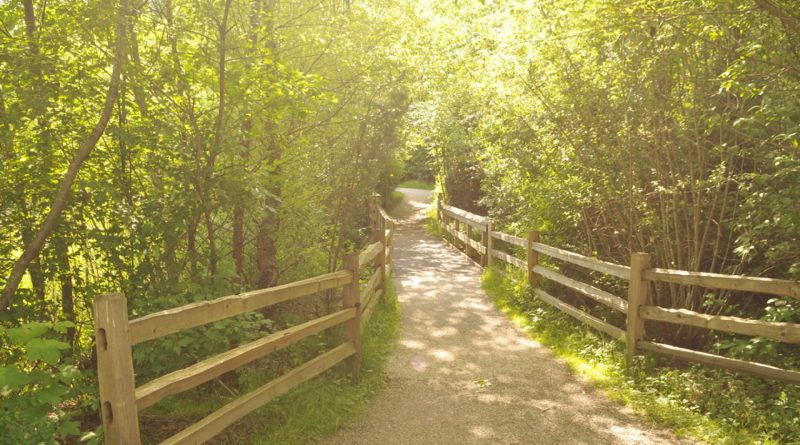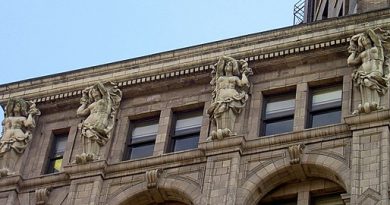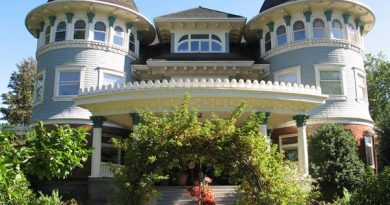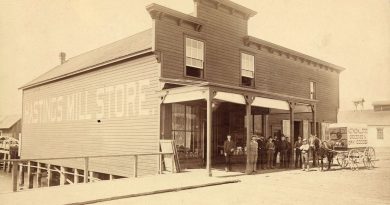Green Timbers
Green Timbers Urban Forest in Surrey is unique: it consists mainly of trees planted from seedlings in the first attempt at reforestation in British Columbia. It sits on a square mile of forest astride the Fraser Highway. Stand by that highway and look east, and you’re directly facing Mount Baker. This highway was originally the Yale Wagon Road to the interior, built by the Royal Engineers in 1875. In 1923 it was renamed the Pacific Highway when Surrey was linked by road to Blaine in Washington State.
We got that information from a web site established by the Green Timbers Heritage Society, who act as the steward of the Forest. Since 1987 the society has been working closely with Surrey Parks, Recreation and Culture to improve the trails and open the forest up to residents of Surrey for recreation and to advance education about the forest and its plants and wildlife.
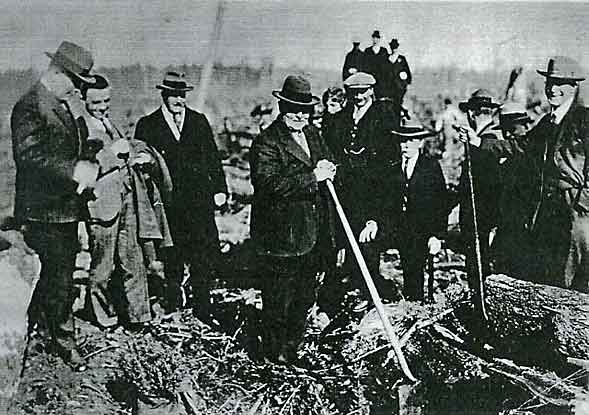
Others, left to right: Colonel Nelson Spencer, young Tom Berry, MLA Mike Manson, Peter Z. Caverhill (Chief Engineer), and Ed Walmsley (land agent), resting foot on log.
Writes Terri Clark of the Vancouver Parks Board in The Greater Vancouver Book, “Green Timbers was, at the turn of the [20th] century, the only remaining stretch of virgin forest between San Diego and Vancouver. Tourists would come from all over to view these cathedral-like groves in a 5,000-acre refuge. Despite proposals to have the forest declared a park, Green Timbers was clear-cut by 1929, the entire population of trees lost to feed a local sawmill.”
The company that did much of that clear-cut work was King Farris Lumber. Surrey historian Jack Brown has an interesting site on early logging in northern Surrey here.
On March 15, 1930 a group of people gathered in the Forest—located at 140th Street and 96th Avenue in Surrey—to plant more than 120 baby trees in B.C.’s first “forest plantation,” the beginning of commercial reforestation here. Guests at the ceremony were invited to plant trees, and Victor Harbord-Harbord, a Province reporter covering the story, planted a Douglas fir for the paper. We mention Harbord-Harbord specifically because 60 years later, to the day, two of Harbord-Harbord’s great-grandchildren romped and chased each other beneath the very tree planted by their late great-grandfather. It’s still there.
And so is a tree planted by another Province writer, Chuck Davis, on that anniversary date: March 15, 1990. By the way, the size of Green Timbers had gone down to 560 acres.
The Green Timbers Heritage Society website says, in part, “the Society was incorporated with the aim of preserving the square mile of forest, which was replanted in the 1930s after it was logged, and then dedicated by the Tolmie government to remain treed. Eventually the City of Surrey traded land on 192nd Street in exchange for a major part of the forest. We thought the forest was finally saved. However a former Surrey mayor thought he had a better idea and logged a major section of the forest in 1987 to build a football stadium and parking lot.
“Our Society took up the torch and fought to keep the forest in its natural state. Working closely with the City Council we managed to get a referendum passed by residents that saved the forest from the football stadium. But we only saved the urban forest from 92 to 100 avenues.
“The city councillors wanted to sell the forest land north of 100 Avenue to developers for residential condominiums. The City was offered $32 Million for the land. The Green Timbers Heritage Society thought it was worth more to leave it as forest. The City called another referendum and 97 per cent of citizens supported keeping it as a forest. While the Society was trying to save this part of the forest, they built trails through it connecting this section of the forest with the rest of Green Timbers.

“Over the years the Society has raised hundreds of thousands of dollars for work in the forest. All the trails are now built to high standards and with bridges and gravel they are passable all year long. The Society also manages a program called Surrey Stewardship of Natural Areas Partnership (SSNAP). It is a partnership between five environmental groups in Surrey managed by the Green Timbers Heritage Society. Four to five university students are hired to work in Surrey forests and parks from May to the end of August. The Society is a wholly volunteer-run organization and any money raised goes directly into the forest. Volunteers are needed for trail building and tour guides work.”
“A forest nursery and forestry training and education centre have been established there. The forest is home to many species of animal and birds, as well as plants, like the protected Western Trillium and the rare Rattlesnake Plantain and Coral-root Orchid. It is the source of King Creek which flows into Bear Creek and eventually into the Serpentine River.
“As a natural heritage, it is potentially one of the most spectacular urban forests in Canada.”
Our thanks to Peter Maarsman of Green Timbers Heritage Society for his invaluable help in presenting this item.

